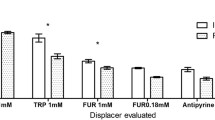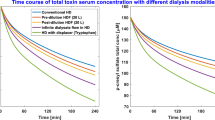Summary
The plasma (or serum) protein binding of disopyramide (DSP) in five haemodialysis patients was studied using an ultrafiltration technique. There was an increase in the free fraction of DSP in the plasma on dialysis days in comparison to the levels on interdialysis days, which was associated with an elevation of the free fatty acid levels in the plasma together with the increase of the free fraction of DSP. The inhibitory effect of free fatty acids on DSP binding in an in vitro study was enhanced in proportion to their concentrations, and was shown to be due to competition at one binding site by experiments with oleic acid as a representative displacer.
Certain endogenous organic acids, such as indoxyl sulphate, 2-hydroxyhippuric acid and hippuric acid, which are characteristically elevated in chronic renal failure, scarcely affected the protein binding of DSP. The findings indicate that free DSP should be monitored in patients with elevated plasma free fatty acid levels, such as those on haemodialysis therapy.
Similar content being viewed by others
References
Lima JJ, Boudoulas H, Blanford M (1981) Concentration-dependence of disopyramide binding to plasma protein and its influence on kinetics and dynamics. J Pharmacol Exp Ther 219: 741–747
Huang J-D, Øie S (1982) Effect of altered disopyramide binding on its pharmacologic response in rabbits. J Pharmacol Exp Ther 223: 469–471
Wilkinson GR, Shand DG (1975) A physiological approach to hepatic clearance. Clin Pharmacol Ther 18: 377–390
Lima JJ (1983) Experimental evidence for concentration-dependent plasma protein binding effects on the apparent half-lives of restricted cleared drugs. J Pharm Sci 72: 461–462
Meffin PJ, Robert EW, Winkle RA, Harapat S, Peters FA, Harrison DC (1979) Role of concentration-dependent plasma protein binding in disopyramide disposition. J Pharmacokinet Biopharm 7: 29–46
Giacomini KM, Blaschke TF (1984) Effect of concentration-dependent binding to plasma proteins on the pharmacokinetics and pharmacodynamics of disopyramide. Clin Pharmacokinet 9 [Suppl 1]: 42–48
Norris RLG, Ahokas JT, Ravenscroft PJ, Henry M (1984) Binding of disopyramide to α1-acid glycoprotein in plasma measured by competitive equilibrium dialysis. J Pharm Sci 73: 824–826
Echizen H, Saima S, Umeda N, Ishizaki T (1986) Protein binding of disopyramide in liver cirrhosis and in nephrotic syndrome. Clin Pharmacol Ther 40: 274–280
Routledge PA (1986) The plasma protein binding of basic drugs. Br J Clin Pharmacol 22: 499–506
Haughey DB, Kraft CJ, Matzke GR, Keane WF, Halstenson CE (1985) Protein binding of disopyramide and elevated alpha-1-acid glycoprotein concentrations in serum obtained from dialysis patients and renal transplant recipients. Am J Nephrol 5: 35–39
Horiuchi T, Johno I, Kitazawa S, Goto M, Hata T (1987) Plasma free fatty acids and protein binding of disopyramide during haemodialysis. Eur J Clin Pharmacol 33: 327–329
Haughey DB, Lima JJ (1982) The influence of blood collection technique on serum and plasma protein binding of disopyramide. Eur J Clin Pharmacol 22: 185–189
Nilsen OG, Storstein L, Jacobsen S (1977) Effect of heparin and fatty acids on the binding of quinidine and warfarin in plasma. Biochem Pharmacol 26: 229–235
Kragh-Hansen U (1981) Molecular aspects of ligand binding to serum albumin. Pharmacol Rev 33: 17–53
David BM, Tjokrosetio R, Ilett KF (1983) Plasma protein binding of disopyramide by equilibrium dialysis and ultrafiltration. Ther Drug Monit 5: 81–86
Horiuchi T, Johno I, Kitazawa S, Goto M (1988) Determination of free disopyramide concentrations using fluorescence polarization immunoassay. Drug Intel Clin Pharm 22: 507
Mizuno K, Toyosato M, Yabumoto S, Tanimizu I, Hirakawa H (1980) A new enzymatic method for colorimetric determination of free fatty acids. Anal Biochem 108: 6–10
Klotz IM, Hunston DL (1975) Protein interactions with small molecules: Relationships between stoichiometric binding constants, site binding constants, and empirical binding parameters. J Biol Chem 250: 3001–3009
Yamaoka K, Tanigawara Y, Nakagawa T, Uno T (1981) A pharmacokinetic analysis program (MULTI) for microcomputer. J Pharm Dyn 4: 879–885
Lentner C, Deim K, Seldrup J (eds) (1982) Geigy scientific tables, 8th edn, vol 2. Ciba-Geigy Ltd, Basle, p 228
Boberg J, Carlson LA (1964) Determination of heparin-induced lipoprotein lipase activity in human plasma. Clin Chem Acta 10: 420–427
Stanfel LA, Gulyassy PF, Jarrard EA (1986) Determination of indoxyl sulfate in plasma of patients with renal failure by use of ion-pairing liquid chromatography. Clin Chem 32: 938–942
Bowmer CJ, Lindup WE (1982) Decreased drug binding in uraemia: Effect of indoxyl sulphate and other endogenous substances on the binding of drugs and dyes to human albumin. Biochem Pharmacol 31: 319–323
Lichtenwalner DM, Suh B (1983) Isolation and chemical characterization of 2-hydroxybenzoylglycine as a drug binding inhibitor in uremia. J Clin Invest 71: 1289–1296
Fiset C, Vallée F, LeBel M, Bergeron MG (1986) Protein binding of ceftriaxone: Comparison of three techniques of determination and the effect of 2-hydroxybenzoylglycine, a drug-binding inhibitor in uremia. Ther Drug Monit 8: 483–489
Rudman D, Bixler II TJ, Del Rio AE (1971) Effect of free fatty acids on binding of drugs by bovine serum albumin, by human serum albumin and rabbit serum. J Pharmacol Exp Ther 176: 261–272
Wong GB, Sellers EM (1979) Intravascular factors affecting diazepam binding to human serum albumin. Biochem Pharmacol 28: 3265–3270
Kessler KM, Leech RC, Spann JF (1979) Blood collection techniques, heparin and quinidine protein binding. Clin Pharmacol Ther 25: 204–210
Wood M, Shand DG, Wood AJJ (1979) Altered drug binding due to the use of indwelling heparinized cannulas (heparin lock) for sampling. Clin Pharmacol Ther 25: 103–107
Brown JE, Kitchell BB, Bjornsson TD, Shand DG (1981) The artifactual nature of heparin-induced drug protein binding alterations. Clin Pharmacol Ther 30: 636–643
Naranjo CA, Sellers EM, Khouw V, Alexander P, Fan T, Shaw J (1980) Variability in heparin effect on serum drug binding. Clin Pharmacol Ther 28: 545–550
Lima JJ (1986) Disopyramide. In: Evans WE, Schentag JJ, Jusko JJ (eds) Applied pharmacokinetics, 2nd edn. Applied Therapeutics Inc, Spokene, pp 1210–1253
Author information
Authors and Affiliations
Rights and permissions
About this article
Cite this article
Horiuchi, T., Johno, I., Hasegawa, T. et al. Inhibitory effect of free fatty acids on plasma protein binding of disopyramide in haemodialysis patients. Eur J Clin Pharmacol 36, 175–180 (1989). https://doi.org/10.1007/BF00609191
Received:
Accepted:
Issue Date:
DOI: https://doi.org/10.1007/BF00609191




